O Holy Night: Josh Groban
O Holy Night: Josh Groban is a well-known Christmas carol composed by Adolphe Adam in 1847 to the French poem “Minuit, chrétiens” (Midnight, Christians) by a wine merchant and poet, Placide Cappeau (1808–1877).
In Roquemaure at the end of the year 1843, the church organ was recently renovated.
To celebrate the event, the parish priest asked Cappeau, native from this town, to write a Christmas poem, even though the latter never showed an interest in religion, and Cappeau obliged.
Soon after, Adam wrote the music. The song was premiered in Roquemaure in 1847 by the opera singer Emily Laurey.
Unitarian minister John Sullivan Dwight,[2] editor of Dwight’s Journal of Music, created a singing edition based on Cappeau’s French text in 1855. In both the French original and in the two familiar English versions of the carol, as well as many other languages, the text reflects on the birth of Jesus and of humanity’s redemption
Merry Christmas Darling: The Carpenters
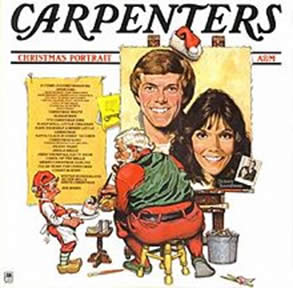 Merry Christmas Darling: The Carpenters is a Christmas song by the Carpenters (music by Richard Carpenter, lyrics by Frank Pooler), and originally recorded in 1970. It was first available on a 7-inch single that year (A&M Records 1236), and was later re-issued in 1974 (A&M 1648) and again in 1977 (A&M 1991). The single went to number one on Billboard’s Christmas singles chart in 1970, and did so again in 1971 and 1973.
Merry Christmas Darling: The Carpenters is a Christmas song by the Carpenters (music by Richard Carpenter, lyrics by Frank Pooler), and originally recorded in 1970. It was first available on a 7-inch single that year (A&M Records 1236), and was later re-issued in 1974 (A&M 1648) and again in 1977 (A&M 1991). The single went to number one on Billboard’s Christmas singles chart in 1970, and did so again in 1971 and 1973.
In 1978, the Carpenters issued their Christmas Portrait album, which contained a new remix of “Merry Christmas Darling”. The original 1970 mix continued to be used for all single releases, however.
The major difference between the 1970 and 1978 versions is a newly recorded vocal by Karen Carpenter on the latter. Richard Carpenter himself calls the original recording one of his sister’s very best. The original single version of the song can be found on the compilation albums From the Top and The Essential Collection: 1965–1997.
Billboard magazine did not display Christmas singles on the Hot 100 in 1970 but the single peaked at number 41 in Cashbox
The Most Wonderful Time of the Year: Andy Williams
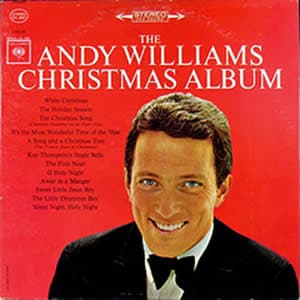 The Most Wonderful Time of the Year: Andy Williams is a popular Christmas song written in 1963 by Edward Pola and George Wyle. It was recorded and released that year by pop singer Andy Williams for his first Christmas album, The Andy Williams Christmas Album. However, the song was not released as a promotional single by Williams’ record label (Columbia Records) that year, as they instead opted to promote his cover of “White Christmas” as the official promo single from the album.
The Most Wonderful Time of the Year: Andy Williams is a popular Christmas song written in 1963 by Edward Pola and George Wyle. It was recorded and released that year by pop singer Andy Williams for his first Christmas album, The Andy Williams Christmas Album. However, the song was not released as a promotional single by Williams’ record label (Columbia Records) that year, as they instead opted to promote his cover of “White Christmas” as the official promo single from the album.
The song is a celebration and description of activities associated with the Christmas season, focusing primarily on get-together between friends and families. Among the activities included in the song is the telling of “scary ghost stories,” a Victorian Christmas tradition that has mostly fallen into disuse, but survives in the seasonal popularity of numerous adaptations of Charles Dickens’ A Christmas Carol. Other activities mentioned include hosting parties, spontaneous visits from friends, universal social gaiety, spending time with loved ones, sledding for children, kissing under the mistletoe, roasting marshmallows, sharing stories about previous Christmases, and singing Christmas carols in inclement weather.
In a 2005 interview, Williams discusses how The Andy Williams Show figured into his recording of “It’s the Most Wonderful Time of the Year”: “George Wyle, who is a vocal director, who wrote all of the choir stuff and all of the duets and trios and things that I did with all the guests, he wrote a song just for the show — I think the second Christmas show we did — called “Most Wonderful Time of the Year”. So I did that, you know, every Christmas, and then other people started doing it. And then suddenly it’s become—not suddenly but over 30 years—it’s become a big standard. I think it’s one of the top 10 Christmas songs of all time now.
A Christmas Gift for You from Phil Spector
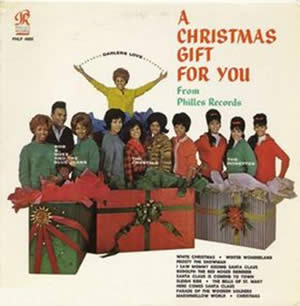 A Christmas Gift for You from Phil Spector is an album of Christmas songs, produced by Phil Spector, and originally released as Philles 45 in 1963. Spector treated a series of mostly secular Christmas standards to his trademark “Wall of Sound” treatment, and the selections feature the vocal performances of Spector’s regular artists during this period.
A Christmas Gift for You from Phil Spector is an album of Christmas songs, produced by Phil Spector, and originally released as Philles 45 in 1963. Spector treated a series of mostly secular Christmas standards to his trademark “Wall of Sound” treatment, and the selections feature the vocal performances of Spector’s regular artists during this period.
The album peaked at number 13 on Billboard magazine’s special, year-end, weekly Christmas Albums sales chart in December 1963. The album was released on 22 November 1963, and was a relative failure at the time. Original pressings are scarce and collectable, now selling for $400–$500 in excellent condition.
In subsequent years, especially after its reissue on Apple, the album grew in popularity and is considered now to be a holiday classic. Several of its tracks became iconic Christmas songs for generations, such as the original (and flop) single “Christmas (Baby Please Come Home),” and the well-known “Ring-a-ling-a-ling Ding-dong-ding” background vocals in The Ronettes’ “Sleigh Ride.”
The arrangement of Bruce Springsteen’s version of “Santa Claus Is Comin’ to Town” is based in part on the Crystals’ version of the song, and U2’s late 1980s cover of “Christmas (Baby Please Come Home)” that appeared on the first A Very Special Christmas album is patterned after the Darlene Love original that appeared on the Spector LP. The Ronettes version of “Frosty The Snowman” and “I Saw Mommy Kissing Santa Claus” also usually get some radio airplay during the holiday season
Little Saint Nick: The Beach Boys
Little Saint Nick: The Beach Boys is a holiday-themed hot rod song about Santa Claus’ sled, written by Brian Wilson and Mike Love for American rock band the Beach Boys.
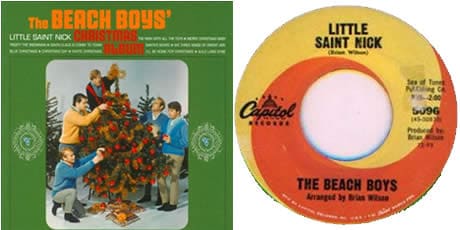
The song was first released as a single on December 9, 1963, and peaked at number 3 on Billboard magazine’s special seasonal weekly Christmas Singles chart. Its B-side was an a cappella cover of “The Lord’s Prayer”.
The idea for the song was partly inspired by record producer Phil Spector’s plans to record a Christmas album. Wilson recalled: “I wrote the lyrics to it while I was out on a date and then I rushed home to finish the music.”
Some of its rhythm and structure derives from the group’s “Little Deuce Coupe”, also co-written by Wilson and released as a single six months earlier. Love was not originally listed as the co-writer of “Little Saint Nick”. His credit was awarded after a 1990s lawsuit.
The single also reached number 69 on the regular weekly sales chart surveyed by Cashbox magazine. Despite a media-hushed Christmas in mourning for recently assassinated President John F. Kennedy, the single went into the Top Tens of Los Angeles, San Diego, Sacramento, Milwaukee, Vancouver and Washington, D.C., and the Top Twenties of San Francisco, Seattle, Minneapolis, Houston, Miami, and Springfield, Massachusetts. Eventually, over several more Christmases, it was credited as an unofficial (non-RIAA audited) million-seller.
Wonderful Christmastime: Paul McCartney
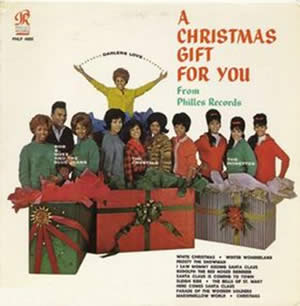 Wonderful Christmastime: Paul McCartney is a 1979 Christmas song by Paul McCartney. It enjoys significant Christmas time popularity around the world.
Wonderful Christmastime: Paul McCartney is a 1979 Christmas song by Paul McCartney. It enjoys significant Christmas time popularity around the world.
The song was later added as a bonus track on the 1993 CD reissue of Wings’ Back to the Egg album. The track was subsequently added as a bonus track to the 2011 reissue of the McCartney II album, with both full and edited versions included. The track was also mixed in 5.1 surround sound for inclusion on the 2007 DVD release The McCartney Years. McCartney recorded the song entirely on his own during the sessions for his solo project McCartney II.
Although the members of Wings are not on the recording, they do appear in the promotional music video, which was filmed at the Fountain Inn in Ashurst, West Sussex.
Following its release as a stand-alone single in the United Kingdom, “Wonderful Christmastime” peaked at No. 6 on the UK Singles Chart the week ending 5 January 1980. In the United States the single peaked at No. 83 on the Cash Box Top 100 Singles chart and No. 94 on the Record World Singles Chart, but did not chart on the Billboard Hot 100.
Do They Know it’s Christmas? Band Aid
Do They Know it’s Christmas? A song written in 1984 by Bob Geldof and Midge Ure in reaction to television reports of the 1983–85 famine in Ethiopia. It was first recorded in a single day on 25 November 1984 by Band Aid, a super group put together by Geldof and Ure and consisting mainly of the biggest British and Irish musical acts at the time.
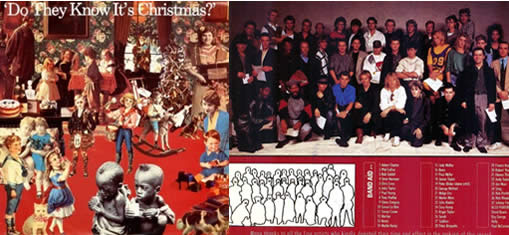
The single was released in the United Kingdom on 3 December 1984 and aided by considerable publicity it entered the UK Singles Chart at number one and stayed there for five weeks, becoming the Christmas number one of 1984. The record became the fastest selling single in UK chart history, selling a million copies in the first week alone and passing 3 million on the last day of 1984, on the way to becoming the biggest selling single of all time in the UK. It held this title until 1997 when it was overtaken by Elton John’s “Candle in the Wind 1997”, released in tribute to Princess Diana following her death. The original version of “Do They Know It’s Christmas?” has sold 3.78 million copies in the UK to date.
The song was also a major success around the world, reaching number one in thirteen other countries outside the UK. In the US, the single fell short of the top ten in the Billboard Hot 100 due to a lack of airplay, but it had sold an estimated 2.5 million copies in the US by January 1985.
Worldwide the single had sold 11.7 million copies by 1989. Geldof’s cautious hope was that the single would raise £70,000 for Ethiopia, but in the event “Do They Know It’s Christmas?” raised £8 million within twelve months of release. The single’s worldwide success in raising awareness and financial relief for the victims of the Ethiopian famine led the recording of several other charity singles in the UK and in other countries, such as “We Are the World” by USA for Africa. The song also led to various spin-off charity events, such as Comic Relief, and the Live Aid concert which would take place seven months later in July 1985.
“Do They Know It’s Christmas?” was re-recorded three times: in 1989, 2004, and 2014. All the re-recordings were also charity records; the 1989 and 2004 versions also provide money for famine relief, while the 2014 version was used to raise funds for the Ebola crisis in West Africa. All three of these versions also reached number one in the UK, and the 2004 version of the song was also a UK million seller, with 1.17 million copies sold.
A Holly Jolly Christmas: Burl Ives
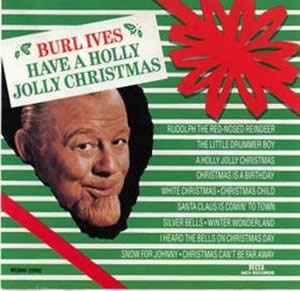 A Holly Jolly Christmas: Burl Ives. A Christmas album by American folk singer Burl Ives, first released by Decca Records in October 1965 (Recorded in November 1964).
A Holly Jolly Christmas: Burl Ives. A Christmas album by American folk singer Burl Ives, first released by Decca Records in October 1965 (Recorded in November 1964).
Ives had recorded two of the songs (“A Holly Jolly Christmas” and “Rudolph the Red-Nosed Reindeer”) the previous year on the Rudolph the Red-Nosed Reindeer soundtrack.
In both cases for this album, Ives re-recorded the tracks (he used a significantly different and slower arrangement for “A Holly Jolly Christmas;” of the two versions Ives recorded, the version on this album is the version more commonly heard on radio in modern times and also appeared on Regular Show episode White Elephant Gift Exchange where Muscle Man opens his present.).
Do You Hear What I Hear: Andy Williams
Do You Hear What I Hear: Andy Williams is a song written in October 1962, with lyrics by Noël Regney and music by Gloria Shayne Baker. The pair, married at the time, wrote it as a plea for peace during the Cuban Missile Crisis. Regney had been invited by a record producer to write a Christmas song, but he was hesitant due to the commercialism of the Christmas holiday. It has sold tens of millions of copies and has been covered by hundreds of artists. Regney wrote the lyrics for the song, while Shayne composed the music in October 1962. This was an unusual arrangement for the two writers. Usually it was Shayne who wrote the lyrics for their songs while Regney composed the music, as they did when they wrote a song based on the classic children’s song “Rain Rain Go Away”.
Regney was inspired to write the lyrics “Said the night wind to the little lamb, ‘Do you see what I see?'” and “Pray for peace, people everywhere” after watching babies being pushed in strollers on the sidewalks of New York City. Shayne stated in an interview years later that neither could personally perform the entire song at the time they wrote it because of the emotions surrounding the Cuban Missile Crisis. “Our little song broke us up. You must realize there was a threat of nuclear war at the time
Silent Night: Josh Groban
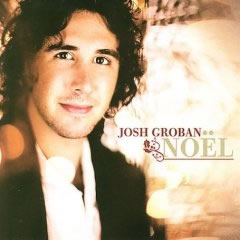 Silent Night: Josh Groban is a popular Christmas carol, composed in 1818 by Franz Xaver Gruber to lyrics by Joseph Mohr in the small town of Oberndorf bei Salzburg, Austria. It was declared an intangible cultural heritage by UNESCO in 2011.
Silent Night: Josh Groban is a popular Christmas carol, composed in 1818 by Franz Xaver Gruber to lyrics by Joseph Mohr in the small town of Oberndorf bei Salzburg, Austria. It was declared an intangible cultural heritage by UNESCO in 2011.
The song has been recorded by a large number of singers from every music genre. The version sung by Bing Crosby is the third best-selling single of all-time. The song was first performed on Christmas Eve 1818 at St Nicholas parish church in Oberndorf, a village in the Austrian Empire on the Salzach river in present-day Austria. A young priest, Father Joseph Mohr, had come to Oberndorf the year before. He had already written the lyrics of the song “Stille Nacht” in 1816 at Mariapfarr, the hometown of his father in the Salzburg Lungau region, where Joseph had worked as a co-adjutor.
The melody was composed by Franz Xaver Gruber, schoolmaster and organist in the nearby village of Arnsdorf. Before Christmas Eve, Mohr brought the words to Gruber and asked him to compose a melody and guitar accompaniment for the church service. Both performed the carol during the mass on the night of December 24.
The original manuscript has been lost. However, a manuscript was discovered in 1995 in Mohr’s handwriting and dated by researchers at c. 1820. It shows that Mohr wrote the words in 1816 when he was assigned to a pilgrim church in Mariapfarr, Austria, and shows that the music was composed by Gruber in 1818. This is the earliest manuscript that exists and the only one in Mohr’s handwriting.
The first edition was published by Friese (de) in 1833 in a collection of Four Genuine Tyrolean Songs, with the following musical text
Santa Claus is Comin’ to Town: Jackson Five
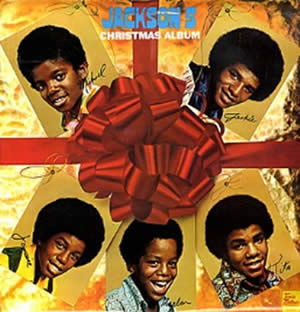 Santa Claus is Comin’ to Town: Jackson Five is a Christmas song. It was written by John Frederick Coots and Haven Gillespie and was first sung on Eddie Cantor’s radio show in November 1934. It became an instant hit with orders for 100,000 copies of sheet music and more than 30,000 records sold within 24 hours.
Santa Claus is Comin’ to Town: Jackson Five is a Christmas song. It was written by John Frederick Coots and Haven Gillespie and was first sung on Eddie Cantor’s radio show in November 1934. It became an instant hit with orders for 100,000 copies of sheet music and more than 30,000 records sold within 24 hours.
The song is a traditional standard at Christmas time and has been covered by numerous recording artists. The 1951 version by Perry Como was the first measurable hit; Gene Autry, the country-western artist, recorded a Christmas album with this title and featuring the song in 1953; and in 1963 the Four Seasons version charted at number 23 on Billboard.
In 1970 Rankin-Bass produced an hour-long animated television special based on the song, with Fred Astaire narrating the origin of Santa Claus. In 1970 Michael Jackson and The Jackson 5 delivered a chart-topping Motown arrangement, and many contemporary artists have recorded and performed various versions of the song, including a rock version by Bruce Springsteen & The E Street Band.
